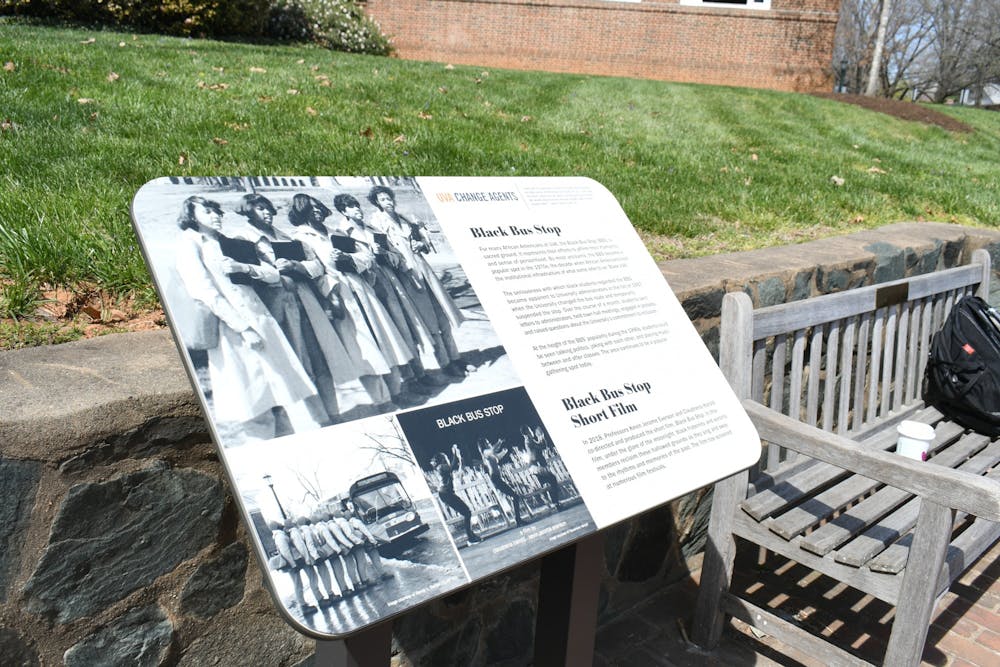This past weekend, over 1,200 alumni and guests attended Black Alumni Weekend events both on and off-Grounds. After the 2021 BAW was postponed due to public health concerns, this was the first in-person BAW since before the onset of the COVID-19 pandemic in 2019. Programming began with a series of dinners on Thursday evening and ran through Sunday afternoon, closing with a faith-based service and brunch at Alumni Hall.
Black Alumni Weekend, a celebration that takes place at the University every two years, began in 1985 by individuals working on the Walter Ridley Scholarship Committee as a mechanism for recruiting students. The Ridley Scholarship Program, named after the first Black graduate of the University, seeks to support Black scholars and represent issues that are meaningful to Black students and alumni. Black Alumni Weekend consists of social functions, lectures and seminars and networking events for alumni and students.
The BAW committee has 154 members, ranging from alumni who graduated last year to those who graduated in 1975. The at-large committee is led by a smaller, six-person steering committee made up of one alumni from each decade between 1970 and 2020. Given the cancellation of BAW last year, the steering committee spent three years planning the events of this weekend.
Kevin Suber, Engineering alumnus, graduated from the University in 1986 and represents the 1980s on the steering committee. Suber spoke to The Cavalier Daily about the intent and meaning of the weekend, highlighting the power of reconnecting the Black community and empowering the next generation of Black leaders.
“Number one is let’s reconnect everybody,” Suber said. “The most powerful colleges and Universities around the world are powerful because they stay connected, and there’s a through line from those that went to those that graduate to those that serve at the University — however they serve.”
The small dinners on Thursday night — which were intended to mimic the intellectual exchange of a French salon— were attended by small groups of faculty, Black alumni, and current Ridley Scholars. Attendees were invited to discuss entrepreneurship, race and politics and mental health.
On Friday, 152 individuals gathered for a conversation between prospective students, alumni and current student leaders. Many of the prospective students were on-Grounds for Spring Fling — an admission open house event like Days on the Lawn that specifically focuses on Black student experiences that happened the same week.
Later that day, almost 200 people participated in a walking panel about the history and planning of the Memorial to Enslaved Laborers hosted by DeTeasa Gathers, co-chair of Descendants of Enslaved Communities at UVA, and Sarita Herman, historic preservation project manager and 2010 alumna. In the evening, Black Voices Gospel Choir — a student performing arts group established in 1972 by Class of 1975 alumnus Reginald Dance — hosted their spring concert entitled ‘Revival!’ in the Newcomb Ballroom.
The next day, hundreds of guests attended a cookout — a longtime BAW tradition full of music, food and drinks — and a talent expo where student groups showcased “some of the University’s top artistic performers,” per the event description.
First-year College Syrell Grier attended the talent expo and said “the vibes were immaculate,” made special by the fact that he was surrounded by those who share a similar culture to him for the weekend. The events felt like a reclamation, to Grier, of a space that was built on the backs of Black enslaved laborers but now is made up of 6.74 percent Black students.
“It felt like for a couple of days the school was ours, it really did, at least from our perspective because that’s the environment we were around,” Grier said. “It was so many Black people here, and that’s not something you see on a daily basis here.”
Grier wasn’t the only student to recognize the importance of Black fellowship at a University currently — and historically — populated primarily by white students. Fourth-year College student Mario Jones said that the weekend is especially “amazing in the sense that it does bring the Black community together” at an institution that doesn’t experience large influxes of Black students.
“I think seeing and hearing from people who have been through what we've been through — or are currently going through — hearing about their problems and their joys that they had here at the University and sharing that common sense among them, it really brings us together,” Jones said. “It actually puts faith in us to know that the work that they put in wasn’t in vain, the work that we're currently putting in isn’t in vain.”
Jones remarked on the University’s decision to host BAW while both Days on the Lawn and Spring Fling are occurring. While BAW is an important event to be celebrated, the decision, for Jones, signals the University using BAW as a “guise” to make admitted students perceive the Black University community as much larger than it actually is.
“BAW [isn’t] representative of the full University experience,” Jones said. “And if you make your decision based off of those, like, snippets that you get during that weekend on Days on the Lawn, then you're going to come to the University and you're going to be bamboozled.”
Saturday afternoon also included an event to commemorate the Black Bus Stop, the UTS bus stop outside Monroe Hall that served as a meeting point and site of gathering for Black students on Grounds from the mid-1970s into the early 2000s. More than 50 people were in attendance, harkening back to what the atmosphere felt like when the Black bus stop was a hub of the University’s Black community.
The commemorative sign placed at the stop was a collaborative project between a number of groups including U.Va Black alumni, the Black Student Alliance’s Political Action Committee, the President’s Office and a working group called the Advisory Committee on the Future of the Historic Landscape, which first officially recommended the spot for a historical marker. The group is a nine-member advisory committee established in Oct. 2017.
Booker Johnson, member of the Black Student Alliance’s Political Action Committee and third-year College student, worked on organizing the Take Back the Bus Stop event for the Committee in concert with the President’s office and BAW organizers. He hopes to keep students aware of this “culturally significant spot” because he said he is “a firm believer that Black history is the University's history.”
“They've given me the liberty to decide, okay, what event do I want to host, what do I want it to look like,” Johnson said. “I don't think it's ever been formally recognized, which is why it's important that a marker is being placed there because this is the first time the University has ever officially taken a stand on something, like yes, this is the Black Bus Stop.”
At the event, alumni spoke about their memories of the bus stop and the significance it held for many generations of students. Gary Flowers, Class of 1985, spoke at the event of the BBS as tradition the reclamation of space at a predominately white institution, which he likened to the struggle of Nat Turner, an enslaved man and religious teacher from Southampton County — located about two and a half hours from Monroe Hall — who in 1831, began a slave rebellion with what ultimately turned into more than 50 enslaved and free Black people revolting against white slaveowners. After the uprising was repressed, Turner was tried and executed, and fear of future rebellion led to widespread backlash leading to killings, mob violence and the passage of new restrictions on Black people by white Virginians.
“There are two perceptions of how we gather and how we define our space by way of Reverend Nat Turner,” Flowers said. “Rev. Turner, to many colonizers and oppressors, was a domestic terrorist. But to his people, he was a freedom fighter. So we gathered here because we wanted a place of our own under the onslaught of everything that was coming to us, and we defined it in our terms.”
Various alumni in attendance emphasized the communication that took place at the BBS before the days of easy digital communication. Class of 1987 alumnus Anthony Bolling described it as a place that met all the needs for the relatively small group of Black students attending the University.
“We didn't have internet, we didn't have cell phones and smartphones to connect with one another,” Bolling said. “We didn’t have apps and taps and all of those things, so how do you, on a campus with less than six percent Black students here, find one another, find out where the parties are, where the information is, where's the hook up on the classes, right? The BBS. Everything for Black students that you wanted and needed was here at the BBS.”
Other alums, like Class of 1991 alumna Syrinda Paige, invoked the sense of community and camaraderie where “you just felt like you were with family.” Dough Smith, Class of 1987, emphasized the sense of safety and comfort that came with having a separate space for Black students to interact.
“It’s a community within a community, and we needed that,” Smith said. “We needed that then, because we weren’t always made to feel comfortable here, so this is where we came and could be comfortable in our own skin, and not feel like we were being attacked, or questioned about why we were here. It was great.”
Class of 2004 alumnus Quentin Washington, who said he was “the mayor of the Black Bus Stop,” described the site as a “fashion show” where students went to see and be seen.
“You would see people who would go to class, and then come back for lunchtime here dressed up,” Washington said. “You would see folks who forgot to do it who would hide—they didn’t want to be seen with their sweats on. It was a good time.”
And despite all the serious reasons for its importance, Class of 1982 alumna Shawn Grain Carter,, noted that in an era when students were still allowed to drink alcohol on-Grounds, the BBS represented a good time.
“Do you know how many hookups happened—not there, but because of it?” Carter said. “Back then, that’s not what we called it.”
There now sits a placard commemorating the site, which will now be passed by hundreds of students crossing McCormick Road to and from their classes, which was installed Thursday. The marker quotes Class of 1991 alumnus Jason Turner, who refers to the bus stop as “the daily center of the Black community at U.Va.” A group of students in the SABLE Society published a letter Wednesday in which they criticized the University administration for going ahead with the marker despite allegedly being notified by students of “several typos and misinformation” on the plaque.
The sign also highlights the short film about the Black Bus Stop produced and directed by professor of art Kevin Jerome Everson and Claudrena Harold, professor of history and African American studies, which was released back in 2018.
As graduation for the Class of 2022 approaches, a new batch of matriculated students will join the ranks of Black alumni who return to Grounds to celebrate their identity and their community. Suber offered recognition for the Black students and alumni who make up an integral part of the University community, noting his appreciation for the ability of Black students who are “sometimes not served” by the University to still connect and find community with one another.
“Virginia turns out the best people in the world — the best influencers in the world,” Suber said. “Some of the finest people you will ever meet have attended the University of Virginia, and some of them, by the way, happened to be of African descent. And every two years we gather to celebrate, to connect, to empower, to influence and to inspire each other.”







